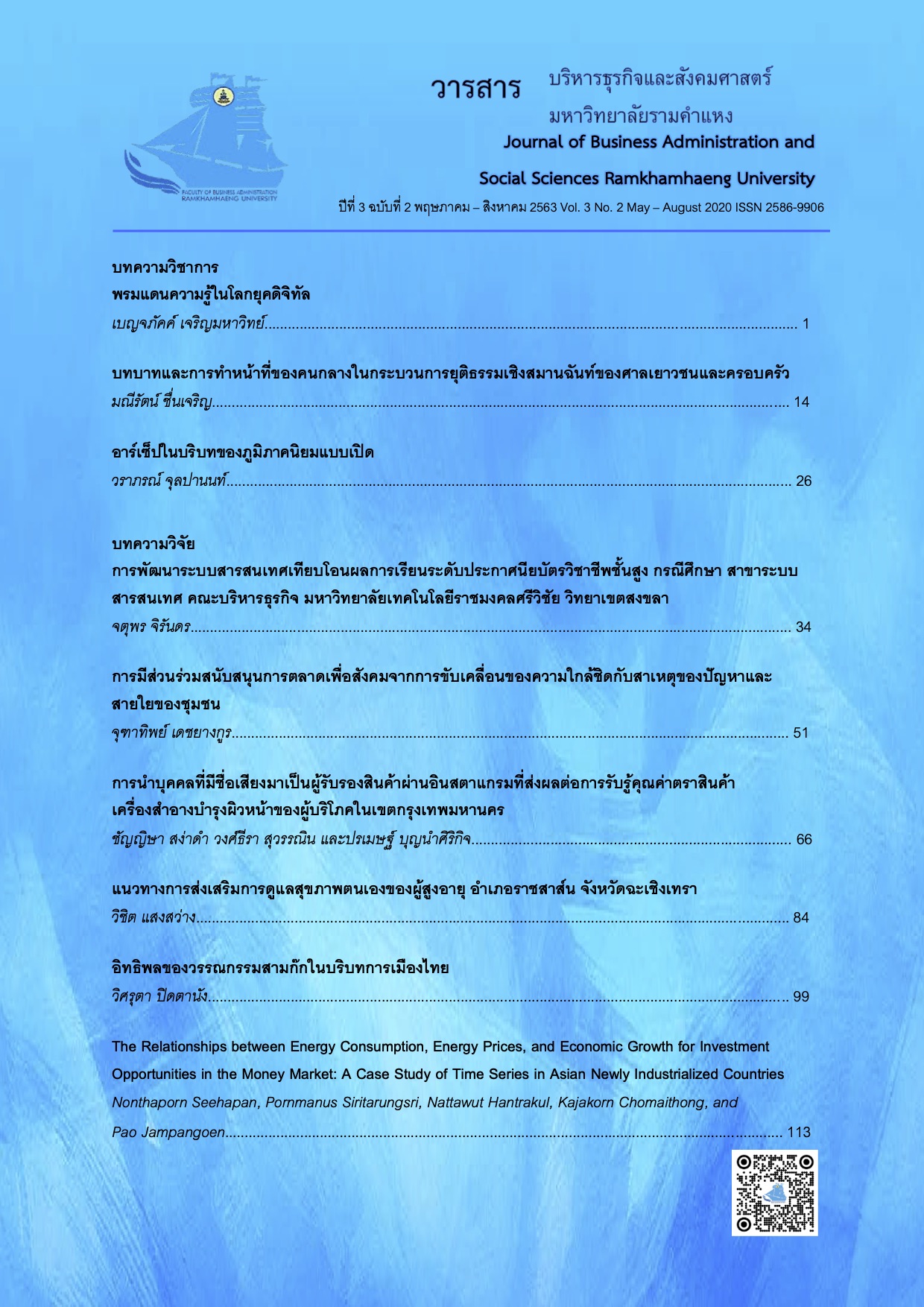The Role and Duties of Mediators in the Restorative Justice Process of the Juvenile and Family Court
Main Article Content
Abstract
In this research investigation, the researcher examines and analyzes the roles and duties of mediators in the restorative justice process of the Juvenile and Family Court.
Findings show that mediators in the Juvenile and Family Court are associate judges who facilitate and mediate conflicts in a restorative justice process. They are called facilitators. Prior to a meeting, facilitators must coordinate and facilitate the parties in the appointment of the date, time, and location of the meeting. During the meeting facilitators conduct the meeting so both parties can talk and make agreements in order to reach plans for the rehabilitation of children and young persons. Facilitators must follow up the performance and provide the conclusion to make reports. It can be considered that facilitators play roles and duties in facilitating both parties in the negotiation and mediating process. Both the injured person and the offender as well as a person affected can discuss regarding the causes of the offence, the effects on the injured person leading to the remedy in the mental aspect, compensation for the damage and the relationship. The facilitators must have the following qualifications. They must attend a training program and have a record as facilitators to formulate plans for the rehabilitation of children and young persons; to remedy the injured persons; and to have registration and the ethics of persons providing counseling. This is to ensure that the negotiation process proceeds with efficiency in accordance with the restorative justice process.
Article Details
เนื้อหาและข้อมูลในบทความที่ลงตีพิมพ์ในวารสารบริหารธุรกิจและสังคมศาสตร์ มหาวิทยาลัยรามคำแหง ถือเป็นข้อคิดเห็นและความรับผิดชอบของผู้เขียนบทความโดยตรง ซึ่งกองบรรณาธิการไม่จำเป็นต้องเห็นด้วย หรือร่วมรับผิดชอบใดๆ
บทความ ข้อมูล เนื้อหา รูปภาพ ฯลฯ ที่ได้รับการตีพิมพ์ในวารสารบริหารธุรกิจและสังคมศาสตร์ มหาวิทยาลัยรามคำแหง ถือเป็นลิขสิทธิ์ของวารสารบริหารธุรกิจและสังคมศาสตร์ มหาวิทยาลัยรามคำแหง หากบุคคลหรือหน่วยงานใดต้องการนำบทความทั้งหมดหรือส่วนหนึ่งส่วนใดไปเผยแพร่ต่อ หรือเพื่อกระทำการใดๆ จะต้องได้รับอนุญาตเป็นลายลักษณ์อักษรจากวารสารบริหารธุรกิจและสังคมศาสตร์ มหาวิทยาลัยรามคำแหง ก่อนเท่านั้น
References
กิตติพงษ์ กิตยารักษ์. (2543). กระบวนการยุติธรรมบนเส้นทางของการเปลี่ยนแปลง (พิมพ์ครั้งที่ 2). กรุงเทพมหานคร: สำนักพิมพ์วิญญูชน.
กิตติพงษ์ กิตยารักษ์. (2544). ยุทธศาสตร์การปฏิรูปกระบวนการยุติธรรมทางอาญาไทย. กรุงเทพมหานคร: สำนักงานกองทุนสนับสนุนการวิจัย.
จุฑารัตน์ เอื้ออำนวย. (2548). กระบวนการยุติธรรมเชิงสมานฉันท์: การคืน “อำนาจ” แก่เหยื่ออาชญากรรมและชุมชน. กรุงเทพมหานคร: สำนักงานกองทุนสนับสนุนการวิจัย.
จุฑารัตน์ เอื้ออำนวย. (2556). ระบบยุติธรรมและยุติธรรมทางเลือก: แนวการวิเคราะห์เชิงสังคมศาสตร์. กรุงเทพมหานคร: สำนักพิมพ์แห่งจุฬาลงกรณ์มหาวิทยาลัย.
ปฐมพร ธาระวานิช. (2552). การนำกระบวนการยุติธรรมเชิงสมานฉันท์มาใช้สำหรับคดีอาญาที่อยู่ในเขตอำนาจของศาลแขวง. วิทยานิพนธ์นิติศาสตรมหาบัณฑิต, จุฬาลงกรณ์มหาวิทยาลัย.
มัวร์, ซี. ดับเบิลยู. (2542). กระบวนการเจรจาไกล่เกลี่ยคนกลาง: ยุทธศาสตร์การนำไปใช้เพื่อแก้ปัญหาความขัดแย้ง (วันชัย วัฒนศัพท์, สุวิทย์ เลาหศิริวงศ์, และวงศา คงดี, ผู้แปล). ขอนแก่น: สถาบันสันติศึกษา มหาวิทยาลัยขอนแก่น.
ศาลเยาวชนและครอบครัวกลาง. (2562). ส่วนมาตรการพิเศษและคุ้มครองสวัสดิภาพ. คู่มือการอบรมและจดแจ้งผู้ประสานการประชุมจัดทำแผนแก้ไข บำบัด ฟื้นฟู เด็กและเยาวชน และการชดเชยเยียวยาความเสียหายแก่ผู้เสียหาย . การประชุมจัดทำแผนแก้ไข บำบัด ฟื้นฟู เด็กและเยาวชน และการชดเชยเยียวยาความเสียหายแก้ผู้เสียหาย 2562. กรุงเทพมหานคร.
อังคณา บุญสิทธิ์, พวงทิพย์ นวลขาว และรัชดา ไชยโยธา. (2549). กระบวนการยุติธรรมเชิงสมานฉันท์กับวัฒนธรรมการระงับข้อพิพาทในท้องถิ่นไทย. กรุงเทพมหานคร: สำนักงานกองทุนสนับสนุนการวิจัย.
อังคนา บุญสิทธิ์. (2550). การจัดการความขัดแย้งในวิถีทางความยุติธรรมเชิงสมานฉันท์. ดุลพาห, 54(3), 207-217.
Braithwaite, J. (1996). Restorative justice and a better future. Dalhousie Review, 76(1), 9-31.
Braithwaite, J. (1998). Restorative Justice. In Michael Tonry (Ed.), The Handbook of Crime & Punishment (pp. 323- 344). Oxford: Oxford University Press.
Roach, K. (2000). Changing punishment at the turn of the century: Restorative justice on the rise. Canadian Journal of Criminology, 42(3), 249-280.
Zehr, H. (2002). The Little Book of Restorative Justice. Pennsylvania: Good Books.


